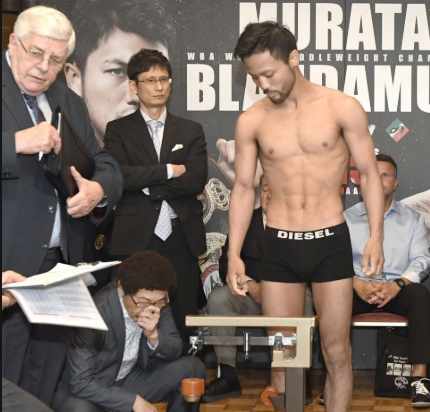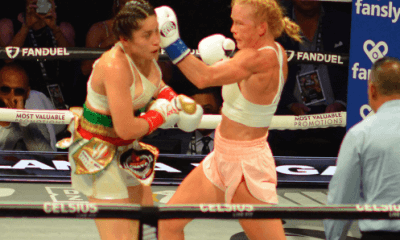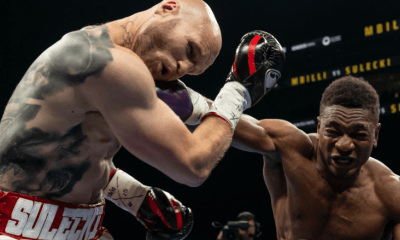Featured Articles
Making Boxing Safer, A Call to Action: Part One, Weigh-in Reform

Promoters Lou DiBella and Eddie Hearn set the stage for this article with heartfelt and moving comments about the recent and tragic passing of Patrick Day.
It becomes very difficult to explain away or justify the dangers of boxing at a time like this…This is not a time where edicts or pronouncements are appropriate, or the answers are readily available. It is, however, a time for a call to action. While we don’t have the answers, we certainly know many of the questions, have the means to answer them, and have the opportunity to respond responsibly and accordingly and make boxing safer for all who participate. — Lou DiBella
You can say ‘it’s boxing’ but it’s so hard to justify. We have to make sure as a sport we do better in this situation…We need to respect these fighters, we need to make sure that we make it as safe as possible for them and as fans of the business we’ve got to keep evolving. There’s so much more we can do. — Eddie Hearn
In the spirit of the above, I reached out to a mix of trainers, ex-boxers, and writers for their suggestions, asking them what a call to action might include. The response was impressive. While the answers varied, there were several recurrent themes. Weigh-in reform was a common thread.
Weight Control Reforms
Las Vegas neurologist Dr. Margaret Goodman, the Founder, President, and Board Chairman of VADA (Voluntary Anti-Doping Association), offered up many suggestions but underlined weigh-in reform for added emphasis. “Move the weigh-in back to day of the fight or 24 hrs. before with the second weigh-in day of with percentage maximum weight gain,” she wrote.
Max Kellerman of “Outside the Lions” concurs. “Weigh-ins should be the day of the fight,” he says.
Hall of Famer Buddy McGirt, the noted trainer and former two-division world champion hit on this point in a recent conversation with Michael Rosenthal that ran in USA Today: “They should have the weigh-ins the day of the fight…listen, guys don’t fight at their normal weight because they know they have 24 hours to put weight on. Make the weigh-ins the day of the fight. Then you would know that you can’t really dry out and then have an IV and fight five, six hours later…I think you’d have less injuries. Say you’re trying to make 140 when you should realistically be at 147. You weigh, say, 143 and think, ‘I can get down to 140.’ But you have to dehydrate yourself, and that’s not good for your body or your brain. I’m not a doctor, but I’m not an idiot either.”
Former world middleweight champion Dana Rosenblatt is in perfect accord: “Due to the fact that 100% of brain injuries in boxing being the result of dehydration from making weight, the most important thing that can be done to safeguard fighters is to make sure that our brothers in the ring never fight when they are not properly hydrated.
“Some of us can take punches better than others, this is obvious. None of us can take punches for too long when we are materially dehydrated without suffering in potentially life-threatening ways. If real care for the health of boxers is to be demonstrated, it will come in boxing commissions worldwide never allowing a fighter to enter the ring before being properly rehydrated after making weight. I am sure a hydration test can eventually be created and administered that would allow all boxers to compete in a healthy way.”
Writer Paul Magno dealt with this issue brilliantly in a story that appeared in the Boxing Tribune back in 2013: “Fighters who routinely compete below their natural body weight are playing an ugly game with their insides, putting themselves at risk of serious injury by dehydrating themselves and then, in the day or so between weigh-in and the fight, quickly re-hydrating to a much higher weight. The primary danger to the fighter is in the increased vulnerability of the brain, slow to rebuild its jelly-like protective layer due to dehydration.”
More recently, Magno made this observation: “Fighters fighting at artificially low weights may have short term advantages in strength and power, but weight manipulation drains life from fighters over the long haul. As a fighter ages, the less he has to battle at the scale, the fresher he’ll enter the ring.”
The Gatti Episode
We are reminded that Arturo Gatti nearly killed Joey Gamache in a 2000 junior welterweight bout when he entered the ring as a middleweight. He had gained 19 pounds between the weigh-in Friday afternoon and the fight on Saturday. Something was dangerously amiss and it resulted in altering Joey’s life…
The Jacobs Episode
Similarly, but with a far better outcome, Gennady Golovkin weighed 159.6 lb. while his opponent, Danny Jacobs weighed 159.8 at the official weigh-in a day before their March 2017 fight. However, by skipping a fight-day weight check and thereby declining to compete for the IBF title, Danny seemed to have gained significantly coming into the ring and looked to be around 180 pounds. Max Kellerman suggested he was utilizing a “strategic plan.” Others (myself included) thought he was also manipulating the system, thus causing the playing field to become uneven.
Historian and writer Harry Otty made an interesting point: “With boxers also trying to shoe-horn themselves into the ‘closest’ weight division it may be time to re-consider the ‘Jnr’ and/or ‘super’ weight divisions. While this may sound counter-intuitive as far as weight-making goes, it could make the difference between 1% or 5% dehydration.”
“Travelin’ Man” Lee Groves, author, writer and CompuBox punch counter, offered up a more nuanced point of view: “As far as returning to same-day weigh-ins, there are pros and cons. On the positive side, one can better control the dramatic rehydrations that now take place but on the negative side it would cause some fighters to drain themselves and be given less time to recover from the strain — the very reason today’s protocols were adopted a generation ago. While reintroducing same-day weigh-ins could persuade some fighters to think twice about campaigning in a weight class too light for their bodies, others will choose to roll the dice and reap the benefits of scaling a certain weight for 30 seconds, then fighting at a much higher weight on fight night. In short, if a system can be gamed, it will be gamed.”
And finally, let me throw out this point to ponder: Over the years, relatively fewer ring fatalities have occurred among the heavyweights. Whether that’s because weight-cutting is, by definition, not as much an issue is something that warrants further study.
Ted Sares can be reached at tedsares@roadrunner.com
Check out more boxing news on video at The Boxing Channel
To comment on this story in The Fight Forum CLICK HERE
-

 Featured Articles3 weeks ago
Featured Articles3 weeks agoAvila Perspective, Chap. 330: Matchroom in New York plus the Latest on Canelo-Crawford
-

 Featured Articles1 week ago
Featured Articles1 week agoVito Mielnicki Jr Whitewashes Kamil Gardzielik Before the Home Folks in Newark
-

 Featured Articles4 weeks ago
Featured Articles4 weeks agoAvila Perspective, Chap 329: Pacquiao is Back, Fabio in England and More
-

 Featured Articles3 weeks ago
Featured Articles3 weeks agoOpetaia and Nakatani Crush Overmatched Foes, Capping Off a Wild Boxing Weekend
-

 Featured Articles2 weeks ago
Featured Articles2 weeks agoCatching Up with Clay Moyle Who Talks About His Massive Collection of Boxing Books
-

 Featured Articles3 weeks ago
Featured Articles3 weeks agoFabio Wardley Comes from Behind to KO Justis Huni
-

 Featured Articles4 weeks ago
Featured Articles4 weeks agoDelving into ‘Hoopla’ with Notes on Books by George Plimpton and Joyce Carol Oates
-

 Featured Articles1 week ago
Featured Articles1 week agoMore Medals for Hawaii’s Patricio Family at the USA Boxing Summer Festival





















